Schwerin
 From Handwiki
From Handwiki Schwerin | |
|---|---|
Town | |
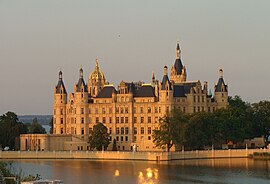      From top down, left to right: Schwerin Castle, Clergymen's Pond and Schwerin Cathedral, castle garden, Mecklenburg State Theater, view of Lake Schwerin from St Paul's Church, view over the city | |
 Flag  Coat of arms | |
 Schwerin 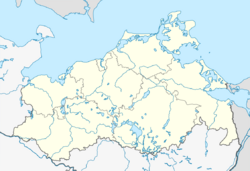 Schwerin | |
| Coordinates: [ ⚑ ] : 53°38′N 11°25′E / 53.633°N 11.417°E | |
| Country | Germany |
| State | Mecklenburg-Vorpommern |
| District | Urban district |
| Subdivisions | 18 boroughs |
| Government | |
| • Lord mayor (2016–23) | Rico Badenschier[1] (SPD) |
| Area | |
| • Total | 130.46 km2 (50.37 sq mi) |
| Elevation | 38 m (125 ft) |
| Time zone | UTC+01:00 (CET) |
| • Summer (DST) | UTC+02:00 (CEST) |
| Postal codes | 19053, 19055, 19057, 19059, 19061, 19063 |
| Dialling codes | 0385 |
| Vehicle registration | SN |
| Website | schwerin.de |
Schwerin (German: [ʃveˈʁiːn] (![]() listen); Mecklenburgisch-Vorpommersch Low German: Swerin; Polabian: Zwierzyn; Latin: Suerina, Suerinum) is the capital and second-largest city of the northeastern German state of Mecklenburg-Vorpommern as well as of the region of Mecklenburg, after Rostock. It has around 96,000 inhabitants, and is thus the least populous of all German state capitals.
listen); Mecklenburgisch-Vorpommersch Low German: Swerin; Polabian: Zwierzyn; Latin: Suerina, Suerinum) is the capital and second-largest city of the northeastern German state of Mecklenburg-Vorpommern as well as of the region of Mecklenburg, after Rostock. It has around 96,000 inhabitants, and is thus the least populous of all German state capitals.
Schwerin is located on the southwestern shore of Lake Schwerin (Schweriner See), the second-largest lake of the Mecklenburg Lake Plateau after the Müritz, and there are eleven other lakes within Schwerin's city limits. The city is surrounded by the district of Northwestern Mecklenburg to the north, and the district of Ludwigslust-Parchim to the south. Schwerin and the two surrounding districts form the eastern outskirts of the Hamburg Metropolitan Region. The name of the city is of Slavic origin, deriving from the root "zvěŕ" (wild animal) or "zvěŕin" (game reserve, animal garden, stud farm).
Schwerin was first mentioned in 1018 as Zuarina and was granted city rights in 1160 by Henry the Lion, thus it is the oldest city of Mecklenburg-Vorpommern. As main residence of the House of Mecklenburg, a dynasty with Slavic roots also known as the Obotrites or Niklotides, Schwerin was the capital of the Duchy of Mecklenburg-Schwerin from 1379 to 1815, of the Grand Duchy of Mecklenburg-Schwerin (after the duke was elevated to the title of a grand duke) from 1815 to 1918, of the Free State of Mecklenburg-Schwerin from 1918 to 1934, of the State of Mecklenburg (after it was merged with the Free State of Mecklenburg-Strelitz) from 1934 to 1952, and of the District of Schwerin from 1952 to 1990.
The romantic Schwerin Palace, situated on Castle Island between Lake Schwerin and Castle Lake, known for its golden dome, the Castle Church, the throne room, and the Niklot statue, used to be the seat of the dukes and grand dukes of Mecklenburg-Schwerin, and since 1990, it is the seat of the state parliament of Mecklenburg-Vorpommern. Schwerin's silhouette is completed by the towers of Schwerin Cathedral, St Paul's Church and St Nicholas' Church. Because of only minor damage in World War II, the city has a largely intact building structure, both in the Altstadt (Old Town) and Schelfstadt (Reed City) quarters.
Major industries and employers include high technology, machine building, healthcare, government agencies, railway supply, consumer goods and tourism. Schwerin has two academic colleges, the Schwerin campus of the "Fachhochschule des Mittelstands" (University of Applied Sciences of the Mittelstand), and the Schwerin campus of the "Hochschule der Bundesagentur für Arbeit" (University of the Federal Employment Agency). There is a regional airport in Parchim, southeast of the city, while Hamburg Airport serves as the city's main airport.
History
Early years
Schwerin is enclosed by lakes. The largest of these lakes, the Schweriner See, has an area of 60 km2. In the middle part of these lakes there was a settlement of the Slavic Obotrite (dated back to the 11th century). The area was called Zuarin (Polabian Zwierzyn), and the name Schwerin is derived from that designation. In 1160, Henry the Lion defeated the Obotrites and captured Schwerin. The town was later expanded into a powerful regional centre. A castle was built on this site, and expanded to become a ducal palace. It is supposedly haunted by the small, impious ghost, called Petermännchen ("Peterman").
In 1358, Schwerin became a part of the Duchy of Mecklenburg, making it the seat of the duchy from then on. About 1500, the construction of the Schwerin Palace began, as a residence for the dukes. After the division of Mecklenburg (1621), Schwerin became the capital of the Duchy of Mecklenburg-Schwerin. Between 1765 and 1837, the town of Ludwigslust served as the capital, until Schwerin was reinstated.
Recent times
In the mid-1800s, many residents from Schwerin moved to the United States, many to Milwaukee, Wisconsin. Today Milwaukee and Schwerin are sister cities. After 1918, and during the German Revolution, resulting in the fall of all the German monarchies, the Grand Duke abdicated. Schwerin became capital of the Free State of Mecklenburg-Schwerin thereafter.
During World War II, Schwerin was hit by bombs in July 1940, on 7 April 1945 and 19 April 1945.[2] At the end of World War II, on 2 May 1945, Schwerin was taken by United States troops. It was turned over to the British on 1 June 1945, and one month later, on 1 July 1945,[3] it was handed over to the Soviet forces, as the British and American forces pulled back from the line of contact to the predesignated occupation zones.
Schwerin was then in the Soviet Occupation Zone which was to become the German Democratic Republic (GDR). Initially, it was the capital of the State of Mecklenburg which at that time included the western part of Pomerania (Vorpommern). After the states were dissolved in the GDR, in 1952, Schwerin served as the capital of the Schwerin district (Bezirk Schwerin).
After reunification in 1990, the former state of Mecklenburg-Vorpommern was recreated as one of the Bundesländer. Rostock was a serious contender for state capital but the decision went in favour of Schwerin.
Population
| Historical population | ||
|---|---|---|
| Year | Pop. | ±% |
| 1500 | 2,500 | — |
| 1790 | 3,512 | +40.5% |
| 1819 | 5,854 | +66.7% |
| 1840 | 16,648 | +184.4% |
| 1860 | 23,517 | +41.3% |
| 1880 | 30,146 | +28.2% |
| 1900 | 38,667 | +28.3% |
| 1910 | 42,519 | +10.0% |
| 1925 | 48,157 | +13.3% |
| 1933 | 53,621 | +11.3% |
| 1940 | 67,200 | +25.3% |
| 1950 | 93,576 | +39.3% |
| 1961 | 92,902 | −0.7% |
| 1966 | 92,356 | −0.6% |
| 1971 | 100,888 | +9.2% |
| 1976 | 110,051 | +9.1% |
| 1981 | 122,264 | +11.1% |
| 1986 | 128,328 | +5.0% |
| 1991 | 125,959 | −1.8% |
| 1996 | 111,029 | −11.9% |
| 2001 | 99,978 | −10.0% |
| 2006 | 96,280 | −3.7% |
| 2011 | 95,300 | −1.0% |
| 2016 | 96,558 | +1.3% |
| 2021 | 95,740 | −0.8% |
| Population size may be affected by changes in administrative divisions. | ||
Schwerin has a population of about 95,000 and is the smallest state capital of Germany. In East Germany era, Schwerin was a industry city known for its leather productions. In 1991, when Schwerin became the capital of Mecklenburg-Vorpommern state, it had a population of 126,000. After the German Reunification, Schwerin's population started to decline and fell below 100,000 in 2000, so that it lost its official status as a major city. Schwerin is also the only state capital that has no universities.
| Rank | Nationality | Population (31.12.2022) |
|---|---|---|
| 1 | 2,142 | |
| 2 | 1,785 | |
| 3 | 713 | |
| 4 | 541 | |
| 5 | 503 |
Geography
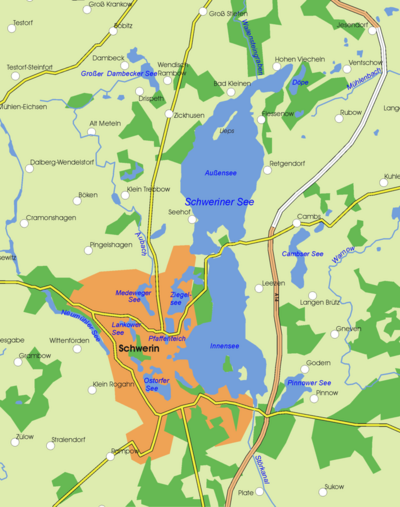
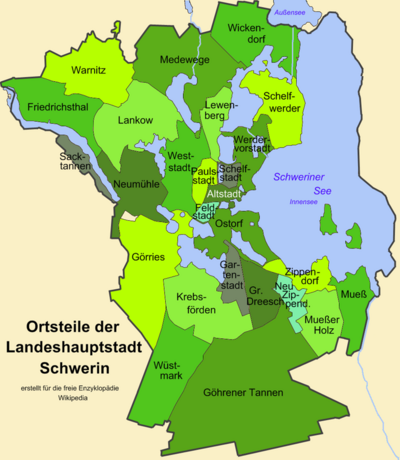
Lakes
The 12 lakes within Schwerin's city limits and their size in km2:
- Lake Schwerin (Schweriner See) 61,5
- Brick Lake (Ziegelsee) 3,0
- Lake Ostorf (Ostorfer See) 2,1
- New Mill Lake (Neumühler See) 1,7
- Lake Medewege (Medeweger See) 1,0
- Lake Lankow (Lankower See) 0,5
- Foul Lake (Fauler See) 0,5
- Heathens Lake (Heidensee) 0,2
- Clergymen's Pond (Pfaffenteich) 0,1
- Castle Lake (Burgsee) 0,1
- Lake Grimke (Grimkesee) 0,04
- Big Karausche (Große Karausche) 0,02
Islands
- Rabbit Ait (Kaninchenwerder) in Lake Schwerin
- Brick Ait (Ziegelwerder) in Lake Schwerin
- Castle Island (Schlossinsel) between Lake Schwerin and Castle Lake
- Big Murrkiten Island (Große Murrkiteninsel) in the Brick Lake
- Small Murrkiten Island (Kleine Murrkiteninsel) in the Brick Lake
- Big Stone (Großer Stein) in Lake Schwerin
Boroughs
The urban area of Schwerin is subdivided into 17 local districts,[4] each with a local council. The districts consist of one or more boroughs. The local councilors have between 5 and 15 members depending on the number of inhabitants. They are determined by the city council for the duration of the election period of the city council after each municipal election. The local councilors are to hear important matters concerning the district and have a right of initiative. However, the final decisions are made by the city council of the city as a whole.
The 17 districts and 26 boroughs:
- Schelfstadt, Werdervorstadt, Schelfwerder (1)
- Altstadt (Old Town), Feldstadt, Paulsstadt, Lewenberg (2)
- Großer Dreesch (formerly Dreesch I) (3)
- Neu Zippendorf (formerly Dreesch II) (4)
- Mueßer Holz (formerly Dreesch III) (5)
- Gartenstadt, Ostorf (formerly Haselholz, Ostorf) (6)
- Lankow (7)
- Weststadt (8)
- Krebsförden (9)
- Wüstmark, Göhrener Tannen (10)
- Görries (11)
- Friedrichsthal (12)
- Neumühle, Sacktannen (13)
- Warnitz (14)
- Wickendorf, Medewege (15)
- Zippendorf (16)
- Mueß (17)
There is a small enclave between the boroughs of Neumühle and Görries, belonging to the neighbouring municipality of Klein Rogahn.
Schwerin clockwise borders the municipalities of Klein Trebbow (N), Seehof (Mecklenburg), Leezen (Mecklenburg) (lake border and border on Paul's Dam (Paulsdamm) only), Raben Steinfeld (E), Plate, Banzkow, Lübesse (S), Holthusen, Pampow, Klein Rogahn (W), Wittenförden, Brüsewitz, and Pingelshagen.
Climate
Script error: No such module "weather box".
Transport
City buses and trams are run by NVS (Nahverkehr Schwerin).[7]
Schwerin Hauptbahnhof (central station) is connected by rail to Berlin, Hamburg and Rostock.
Main sights
- The landmark of the city is the Schwerin Palace, located on an island in the lake of the same name (Schweriner See). It was, for centuries, the residence of the Dukes of Mecklenburg and today is the seat of the Landtag (state parliament).
- Schwerin Cathedral, built in 1260–1416 in Brick Gothic style.
- The Alter Garten (Old Garden) square, surrounded by buildings such as the 18th-century Altes Palais (Old Palace), the neoclassical Staatliches Museum Schwerin (State Art Museum, built in 1877–1882), and the Staatstheater (City Theater, erected in 1886).
- The city hall (18th century).
- Schelfkirche (Saint Nicolai Church), originally built 1238, but rebuilt in 1713 after destruction by a storm.
- TV Tower Schwerin-Zippendorf.
Museums
- The Staatliches Museum Schwerin-Kunstsammlungen (State Art Museum) houses a remarkable collection of 17th-century Dutch paintings and German art from medieval and renaissance masters up to the present day. There are also a collection of Greek vases, the notable collection of Paintings of Jean-Baptiste Oudry, a collection of sculptures of Houdon, German 18th-century court paintings, and works by such modern artists as Max Liebermann, Franz Stuck, Marcel Duchamp etc. The Graphic cabinet houses rich collections of Dutch and German drawings and prints (Jan van Goyen, Dürer, Cranach, Rembrandt, Merian) and a notable collection of coloured graphics from the time of the GDR.
- The State Museum of Technology (Technische Museum), housed in the former Marstall (Royal Stables). In 2012 the Technische Museum moved to the city of Wismar located 40 km north of Schwerin.
Crime rate
According to the official 2007 Crime Report for Germany, Schwerin was the only German city with a crime rate over 17,000 total offenses committed per 100,000 inhabitants;[8] thus being 1st in the list of Germany's most dangerous cities. The larger cities, such as Berlin, Frankfurt am Main, or Bremen, all have crime rates ranging from 14,000 to 16,000 total offenses committed per 100,000 people. However, Schwerin is the only city where riding a bus (or tram) without a ticket and social security fraud is counted towards the crime rate, significantly boosting the numbers.[9]
Twin towns – sister cities
Schwerin is twinned with:[10]
 Odense, Denmark
Odense, Denmark Piła, Poland
Piła, Poland Reggio Emilia, Italy
Reggio Emilia, Italy Tallinn, Estonia
Tallinn, Estonia Vaasa, Finland
Vaasa, Finland Växjö, Sweden
Växjö, Sweden Wuppertal, Germany
Wuppertal, Germany
Notable people
.jpg)
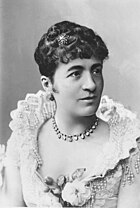
- Konrad Ernst Ackermann (1712–1771), actor
- Friedrich Ludwig Schröder (1744–1816), actor, theatre director and playwright.[11]
- Karl Albert von Kamptz (1769–1849), lawyer, Prussian Minister of Justice from 1832 to 1842.
- Heinrich von Bülow (1792–1846), diplomat and Prussian statesman
- Carl von Lemcke (1831–1913), art historian, songwriter, rector at the University of Stuttgart
- August Kundt (1839–1894), physicist; invented Kundt's tube.[12]
- Walther Flemming (1843 in n Sachsenberg – 1905), biologist and founder of cytogenetics
- Marie Hankel (1844–1929), writer of Esperanto literature and advocate of women's suffrage.
- Hans von Koester (1844–1928), naval officer, became Grand admiral
- Franziska Ellmenreich (1847–1931), actress
- Friedrich Klockmann (1858–1937), mineralogist
- Heinrich Friese (1860–1948), entomologist and bee researcher
- Heinrich Cunow (1862–1938), politician (SPD) and writer
- William Berwald (1864–1948), an American composer and conductor
- Hermann Baranowski (1884–1940), Nazi SS concentration camp commandant
- Paul Gösch (1885–1940), painter and architect, Nazi victim
- Bernhard Schwentner (1891–1944), Catholic priest and resistance fighter
- Wilhelm Facklam (1893 in Upahl – 1972), landscape artist and draftsman
- Wilhelm Gustloff (1895–1936), Nazi party leader, worked in Davos, assassinated
- Rudolf Metzmacher (1906–2004), cellist
- Ludwig Bölkow (1912–2003), industrialist and aeronautical pioneer
- Gudrun Zapf-von Hesse (1918–2019), typographer calligrapher and bookbinder
- Verena Keller (born 1940), mezzo-soprano
- André Brie (born 1950), politician (The Left), Member of the European Parliament, 1999/2009
- Katrin Sass (born 1956), actress
- Heidrun Bluhm (born 1958), politician (The Left)
- Oliver Riedel (born 1971), musician, member of the band Rammstein
Aristocracy

- Albert II, Duke of Mecklenburg (ca 1318 – 1379), feudal lord in Northern Germany
- Sophia Louise of Mecklenburg-Schwerin (1685 – 1735 in Schwerin Castle). Queen consort in Prussia by marriage to King Frederick I of Prussia
- Frederick Francis I (1756–1837), ruler as duke 1785/1815, and as grand duke 1815/1837
- Duchess Louise Charlotte of Mecklenburg-Schwerin (1779–1801), maternal grandmother of Prince Albert, the husband of Queen Victoria
- Duke Adolf Friedrich of Mecklenburg (1873–1969), Africa traveler, colonial politician and first President of the German Olympic Committee
- Alexandrine of Mecklenburg-Schwerin (1879–1952), Queen of Denmark, 1912/1947 & Queen of Iceland, 1918/1944
- Duchess Cecilie of Mecklenburg-Schwerin (1886–1954), last Crown Princess of the German Empire
- Friedrich Franz, Hereditary Grand Duke of Mecklenburg-Schwerin (1910–2001), heir apparent to the Grand Duchy of Mecklenburg-Schwerin
Sport

- Manfred Schneider (born 1941), rower, bronze medallist at the 1972 Summer Olympics
- Detlef Pirsig (1945–2019), footballer player and manager; he played 385 matches
- Gabriele Hinzmann (born 1947), discuss thrower; bronze medallist at the 1976 Summer Olympics
- Wolf-Rüdiger Netz (born 1950), former footballer, played over 300 games
- Anke Westendorf (born 1954), Olympic volleyball player
- Rosemarie Gabriel (born 1956), swimmer, team gold and silver medallist at the 1976 Summer Olympics
- Andrea Pollack (born 1961), swimmer, multiple medallist at the 1976 & 1980 Summer Olympics
- Torsten Bréchôt (born 1964) judoka, bronze medallist at the 1988 Summer Olympics
- Steffen Zühlke (born 1965), rower, bronze medallist at the 1988 Summer Olympics
- Matthias Stammann (born 1968), footballer, played 299 games
- Sylvia Roll (born 1973), Olympic volleyball player
- Hanka Durante (born 1976), Olympic volleyball player
- Robert Müller (born 1986), footballer, played 489 games
- Peter Kretschmer (born 1992), sprint canoer, gold medallist at the 2012 Summer Olympics
Gallery

Mecklenburg State Theatre
.jpg)
Castle of Schwerin in the evening

View of the old town
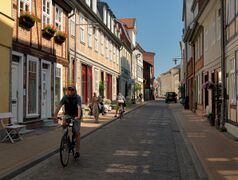
Schelfstadt

Aerial view of Schwerin
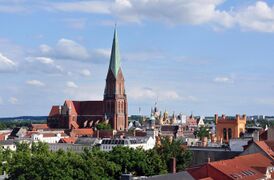
Schwerin Cathedral in the city centre
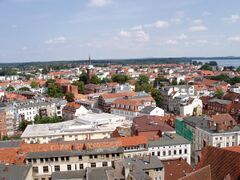
Schelfstadt and its baroque Schelf Church, Lake Schwerin in the back
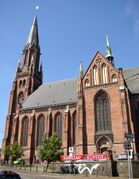
Saint Paul's Church
.jpg)
Former power station (E-Werk)
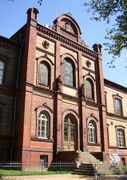
FHM, private university
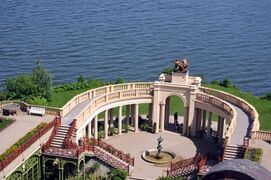
Castle orangerie

State Museum and Mecklenburg State Theatre
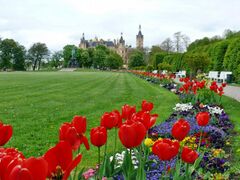
Schlossgarten

References
- ↑ Kommunalwahlen in Mecklenburg-Vorpommern, Ergebnisse der Bürgermeisterwahlen, Mecklenburg-Vorpommern, Landesamt für innere Verwaltung, accessed 2 August 2021.
- ↑ "April 1945: Bomben auf Schwerin". https://www.ndr.de/geschichte/chronologie/kriegsende/19-April-1945-Bomben-auf-Schwerin,bombenschwerin100.html.
- ↑ Some evidence[citation needed] calls into doubt the date on which the British withdrew to the predesignated occupation zone. Local residents claim that the British forces did not relinquish control of Schwerin until later in the year, probably November, following a brief artillery exchange across lake Schwerin between the British and the Soviets. Allegedly there were no deaths.
- ↑ "Stadtteile" (in de). https://www.schwerin.de/kultur-tourismus/stadtportrait/stadtteile/.
- ↑ "World Meteorological Organization Climate Normals for 1991–2020". World Meteorological Organization Climatological Standard Normals (1991–2020). National Oceanic and Atmospheric Administration. https://www.nodc.noaa.gov/archive/arc0216/0253808/1.1/data/0-data/Region-6-WMO-Normals-9120/Germany/CSV/Schwerin_10162.csv.
- ↑ "Normals et records climatologiques 1991-2020 à Schwerin" (in fr). Infoclimat. https://www.infoclimat.fr/climatologie/normales-records/1991-2020/schwerin/valeurs/10162.html.
- ↑ NVS (Nahverkehr Schwerin)
- ↑ Official Police Report for Germany, cf. p. 17.
- ↑ "19.05.07 / Aufgeklrt: Das wilde Rubernest Schwerin". http://www.webarchiv-server.de/pin/archiv07/2020070519paz13.htm.
- ↑ "Städtepartnerschaften" (in de). Schwerin. https://www.schwerin.de/kultur-tourismus/Information/stadtportrait/staedtepartnerschaften/.
- ↑ "Schröder, Friedrich Ludwig". Encyclopædia Britannica. 24 (11th ed.). 1911. pp. 378-379.
- ↑ "Kundt, August Adolph Eduard Eberhard". Encyclopædia Britannica. 15 (11th ed.). 1911. p. 946.
External links
| Wikivoyage has a travel guide for Schwerin. |
| Wikimedia Commons has media related to Schwerin. |
- Tourism portal of Schwerin (in English)
 |
Categories: [German state capitals]
↧ Download as ZWI file | Last modified: 05/26/2025 18:43:03 | 6 views
☰ Source: https://handwiki.org/wiki/Place:Schwerin | License: CC BY-SA 3.0

 KSF
KSF